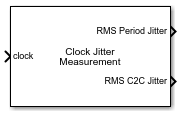Clock Jitter Measurement
Libraries:
Mixed-Signal Blockset /
Utilities
Description
Use the Clock Jitter Measurement block to measure the RMS (root mean squared) periodic jitter in clock signals. You can also measure cycle-to-cycle (C2C) jitter and duty cycle distortion (DCD).
Ports
Input
Input clock signal, specified as a scalar. The input signal must have only one threshold crossing per period.
Data Types: double
Output
Running RMS value of the period jitter calculated up to the current time step, returned as a scalar. Period jitter is the deviation in the cycle time of a clock signal with respect to the ideal period.
Data Types: double
Running RMS value of the cycle-to-cycle jitter calculated up to the current time step, returned as a scalar. Cycle-to-cycle jitter is the difference in the period between the two consecutive cycles of the clock.
Dependencies
To enable this port, select Cycle-2-Cycle (C2C) Jitter.
Data Types: double
Difference between the real duty cycle in percentage and the ideal 50% value, returned as a scalar.
Dependencies
To enable this port, select Duty Cycle Distortion (DCD).
Data Types: double
Parameters
Frequency of the input clock signal, specified as a positive real scalar in Hz. Clock Frequency is used to calculate the ideal value of the period of the input signal.
Programmatic Use
Block parameter:
Frequency |
| Type: character vector |
| Values: positive real scalar |
Default:
1e6 |
Threshold signal level to calculate the rising and falling edge of the signal, specified as a real scalar.
Programmatic Use
Block parameter:
Threshold |
| Type: character vector |
| Values: real scalar |
Default:
0 |
Select to calculate the RMS period jitter. This option is selected by default.
Period jitter is the deviation in the cycle time of a clock signal with respect to the ideal period.
Select to calculate the RMS cycle-to-cycle (C2C) jitter. This option is deselected by default.
Cycle-to-cycle jitter is the difference in the period between the two consecutive cycles of the clock.
Select to calculate the duty cycle distortion for each cycle. This option is deselected by default.
Duty cycle distortion is the difference between the real duty cycle in percentage and the ideal 50% value.
Select the simulation mode. This choice affects the simulation performance.
Simulating the model using the Code generation method
requires additional startup time, but the subsequent simulations run faster. Simulating
the model using the Interpreted execution method may reduce
the startup time, but the subsequent simulations run slower. For more information, see
Interpreted Execution vs. Code Generation.
Version History
Introduced in R2021a
See Also
MATLAB Command
You clicked a link that corresponds to this MATLAB command:
Run the command by entering it in the MATLAB Command Window. Web browsers do not support MATLAB commands.
웹사이트 선택
번역된 콘텐츠를 보고 지역별 이벤트와 혜택을 살펴보려면 웹사이트를 선택하십시오. 현재 계신 지역에 따라 다음 웹사이트를 권장합니다:
또한 다음 목록에서 웹사이트를 선택하실 수도 있습니다.
사이트 성능 최적화 방법
최고의 사이트 성능을 위해 중국 사이트(중국어 또는 영어)를 선택하십시오. 현재 계신 지역에서는 다른 국가의 MathWorks 사이트 방문이 최적화되지 않았습니다.
미주
- América Latina (Español)
- Canada (English)
- United States (English)
유럽
- Belgium (English)
- Denmark (English)
- Deutschland (Deutsch)
- España (Español)
- Finland (English)
- France (Français)
- Ireland (English)
- Italia (Italiano)
- Luxembourg (English)
- Netherlands (English)
- Norway (English)
- Österreich (Deutsch)
- Portugal (English)
- Sweden (English)
- Switzerland
- United Kingdom (English)
